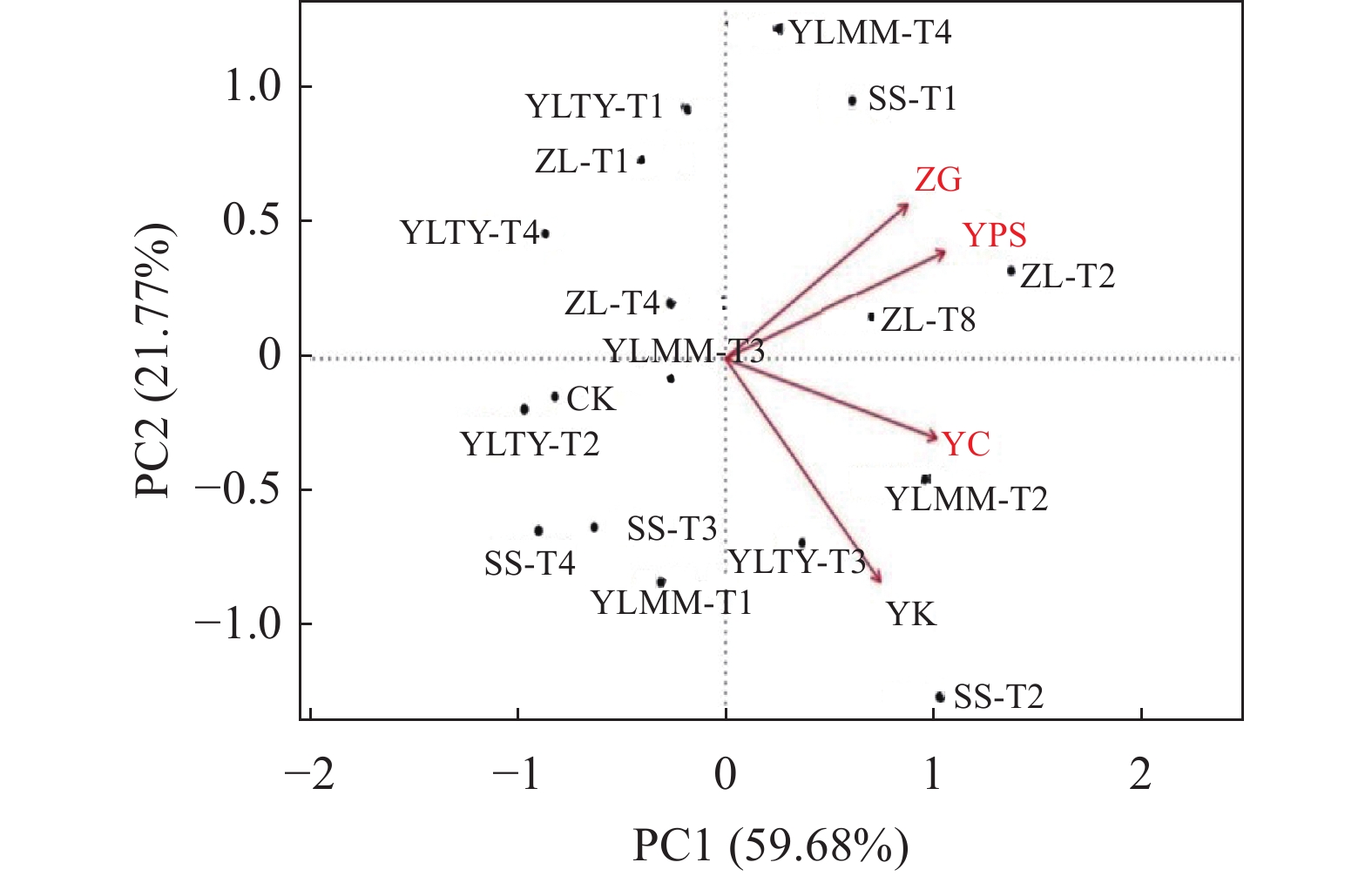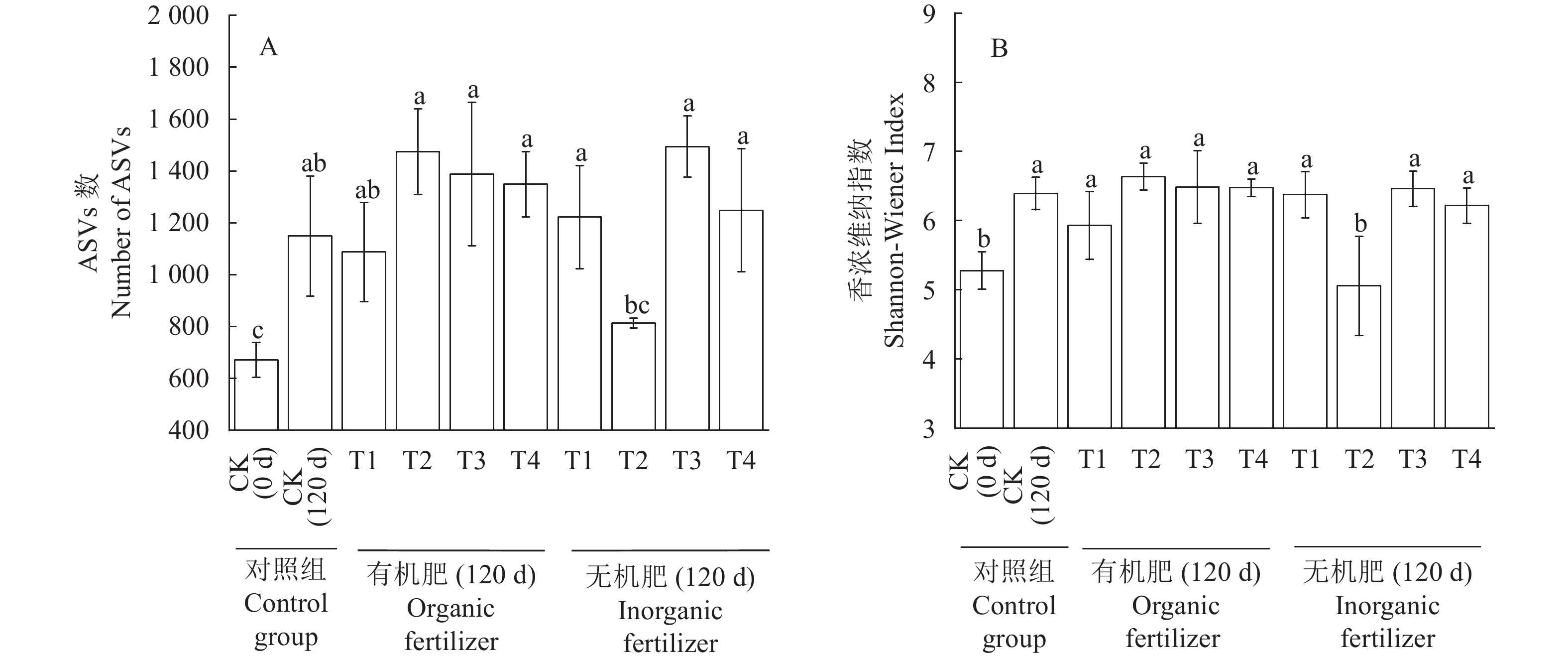Effects of Fertilizers Applied on Growth of Kandelia obovata Seedlings and Microbial Community in Soil
-
摘要:目的 探明肥料种类和施肥量对秋茄(Kandelia obovata)幼苗生长的影响以及土壤微生物的响应。方法 选用3种有机肥和1种无机肥,以不施肥组(CK)为对照,设置了4个施肥量梯度,测定秋茄幼苗株高、叶长、叶宽、叶片数增长量、叶绿素含量,并对土壤微生物群落进行16S rRNA 基因高通量测序。结果 秋茄最适施肥条件是9.74 g·kg−1基质的尊龙牌蚓肥,120 d后株高、叶长、叶宽、叶数增长量比对照组分别增加117.50%、51.15%、63.34%、178.57%。施有机肥、无机肥和对照组的土壤微生物群落组成差异明显,施有机肥土壤中有更多特有的微生物。施有机肥土壤微生物α多样性变化趋势与植物生长指标变化趋势正相关,而施无机肥的呈负相关。表明有机肥可能通过促进土壤微生物与植物协同的方式进而有助于植物生长。施有机肥提高了土壤潜在有益菌,如放线菌门(Actinobacteriota)和Nitrospira、 Nocardioides、Limibaculum属丰度。结论 施适量有机肥协同促进秋茄生长和土壤微生物多样性,而施无机肥对秋茄生长促进作用相对较小,并对土壤微生物多样性产生负面影响。Abstract:Objective Effects of fertilizer type and application rate on the growth of Kandelia obovate seedlings as well as the microbial community in soil were studied.Method In a field experiment, K. obovate seedlings were planted on lots treated by 3 different organic fertilizers or an inorganic fertilizer at 4 application rates, along with no-fertilizer as control (CK). Plant height and leaf length, width, number, and chlorophyll content of the seedling in the autumn were determined. Composition of the microbial community in soil was detected by high-throughput sequencing based on 16S rRNA gene.Result On the lots applied with Zun Long Fertilizer at the rate of 9.74 g·kg−1, the seedlings, in comparison to those on CK, were 117.50% taller and had 51.15% longer, 63.34% wider, and 178.57% more leaves in 120 d. The microbial compositions in the soil at the lots applied with organic fertilizer, inorganic fertilizer, and CK differed significantly. In addition, there were more distinct species on the organic fertilizers-treated soil than on the others. The plant grew positively with the microbial α-diversity in soil treated with the organic fertilizers, but negatively in soil treated with the inorganic fertilizers. Moreover, the organic fertilization fostered proliferation of beneficial microbes, such as Actinobacteriota and genera Nitrospira, Nocardioides, and Limibaculum, which could synergistically promote the plant growth as well.Conclusion Application of organic fertilizer enhanced the growth of K. obovate as well as the microbial diversity of soil. On the other hand, inorganic fertilizer provided relatively limited benefits on the growth of the plants, yet considerably hindered the development of a healthy soil microbiome.
-
Keywords:
- fertilization /
- Kandelia obovate /
- mangrove plant /
- soil microbial community
-
随着生活水平和国民素质的提高,新植物资源的挖掘和利用日益受到重视。传统中药以原料丰富、效果显著、毒副作用小等特点而备受青睐[1]。枇杷是原产我国的亚热带特色果树,其干燥花序作为民间传统中药,具有润五脏、利肺气之功效,有望成为新资源食品。但是生产中有超过90%的枇杷花生物资源缺乏有效利用,仅福建省每年就有约17万t枇杷花被废弃,近年来枇杷花开发利用研究逐步成为研究热点,陆续研制出枇杷花茶或枇杷花复合茶饮料[2-4]。但是枇杷花的功效研究相对单一,多集中在枇杷花的止咳 [5-9] 和抗氧化作用上[10-11],尤其是对枇杷花干预急性炎症和小肠推进作用研究还未见报道。本研究以贵妃枇杷花茶水提物为材料,对其干预炎症和促进小肠运动的作用进行功能验证和分析,为进一步利用枇杷花生物资源奠定理论参考和依据。
1. 材料与方法
1.1 试验材料
试验动物:SD雄性大鼠,清洁级,体重180~200 g;昆明种小鼠,清洁级,雄性,体重18~22 g,购自上海斯莱克实验动物有限公司,许可证号SCXK(沪)2012-0002,药品试剂:醋酸地塞米松片:福州海王福药制药有限公司,国药准字H35020317,批号1403031。复方地芬诺酯片:长春长江制药有限公司,国药准字:H22022037,批号:20130901。二甲苯:上海化学试剂有限公司,每瓶500 mL,AR级,批号:081028枇杷花茶:试验用贵妃枇杷花茶系利用贵妃枇杷品种的新鲜花序开发的饮用茶(ZL200910111385.8)。
1.2 试验方法
贵妃枇杷花水提取物制备:取贵妃枇杷花茶200 g加10倍量的水煎煮2遍,合并滤液,浓缩备用。功能试验中以体重设高剂量组(1.6 g·kg-1)、 中剂量组(0.8 g·kg-1)、低剂量组(0.4 g·kg-1)。
大鼠棉球植入试验操作参照《中药药理研究方法学》[12],手术次日开始灌胃给药,连续 7 d,末次给药1 h后,将棉球连同周围结缔组织一起取出,剔除周围脂肪组织,放烘箱中 50℃烘干 24 h 称干重,该干重减去棉球原重量即得肉芽肿干重。小鼠耳肿胀试验操作参照《药理实验方法学》[13],灌胃给药,1次·d-1,连续7 d,于最后1次给药后1 h,每鼠右耳正反面滴30 μL二甲苯。45 min处死小鼠,剪下双耳,用8 mm打孔器取耳片称重,肿胀度=右耳重-左耳重。小肠推进试验参照《保健食品检验与评价技术规范》[14],灌胃给药7 d后,各组小鼠禁食不禁水16 h。模型对照组和3个剂量组灌胃给予复方地芬诺酯5 mg·kg-1 BW,模型组和正常对照组给等体积蒸馏水。0.5 h后,剂量组分别给予含相应受试样品的墨汁(含5%的活性炭粉、10%阿拉伯树胶),对照组给墨汁灌胃。25 min后立即脱颈椎处死动物,剪取上端自幽门、 下端至回盲部的肠管,测量肠管长度为“小肠总长度”,从幽门至墨汁前沿为“墨汁推进长度”,推进率/%=(墨汁推进长度/小肠总长度)×100%。
1.3 数据统计
试验数据以均值±标准差(X±SD)表示,应用DPS统计软件进行方差分析。
2. 结果与分析
2.1 WGFT对棉球肉芽组织增生的抑制作用
由图 1可见,模型对照组大鼠棉球肉芽肿干重为(18.38±7.32)mg,与正常对照组相比减少66.30%(P<0.01),表明模型建立成功。结果显示不同剂量WGFT均可降低棉球肉芽肿的干重。分析表明,高剂量组WGFT(1.6 g·kg-1·d-1)和中剂量组WGFT(0.8 g·kg-1·d-1)分别比正常对照组棉球肉芽肿干重减少39.98%、40.02%,且有极显著差异(P<0.01)。与醋酸地塞米松模型对照组效果相当。低剂量组(0.4 g·kg-1·d-1剂量组)棉球肉芽干重比正常对照组减少31.98%,差异达到显著差异水平(P<0.05)。说明WGFT可以有效抑制棉球肉芽组织的增生。
2.2 WGFT干预急性炎症的作用
小鼠耳肿胀试验结果显示不同剂量WGFT对耳肿胀程度的影响存在差异,高、中剂量均可降低小鼠耳肿胀程度,且作用明显(图 2)。结果显示高剂量组WGFT(1.6 g·kg-1·d-1剂量组)小鼠耳肿胀程度为(17.19±5.47)mg,与正常对照组比较,降低30.55%,且有极显著差异(P<0.01); 中剂量组WGFT(0.8 g·kg-1·d-1剂量组)小鼠相对于正常对照组的耳肿胀度显著降低(P<0.05),减少了23.47%。但是低剂量组WGFT(0.4 g·kg-1·d-1剂量组)小鼠耳肿胀度与正常对照组相比没有达到显著水平。说明WGFT具有较好的干预急性炎症作用。
2.3 WGFT对小肠运动的推进作用
试验结果显示不同剂量WGFT对肠推进效果的影响存在差异(图 3)。模型对照组的小肠推进率为(34.73±10.71)%,显著低于正常对照组( P<0. 01),说明模型建立成功。与模型对照组比较,高剂量组WGFT(1.6 g·kg-1·d-1剂量组)、中剂量组WGFT(0.8 g·kg-1·d-1剂量组)对模型小鼠的小肠推进作用有显著性差异( P<0.01),分别比模型对照组提高87.19%、68.87%。而低剂量组WGFT推进率比模型组虽然提高37.58%,但是未达到显著水平。
3. 讨论与结论
枇杷花具有很高的营养保健价值,含有丰富的三萜类物质[15],已有的研究表明枇杷花在缓解咳嗽[8]、护肝[16]、抗菌[17]等方面具有明显的效果。本试验通过棉球植入试验和耳肿胀试验均显示枇杷花茶具有显著的干预炎症作用,其中高剂量和中剂量组WGFT均显著抑制耳肿胀作用,这与邓晶晶等[7] 利用枇杷花研究结果趋势相似。
人体排便过程是一系列复杂而协调的生理反射活动,任何环节发生障碍都可以引起便秘,其中肠道运动的调节尤为关键[18]。本研究首次发现WGFT可以显著提高试验小鼠的小肠推进能力,具有明显的改善通便作用。这与猪毛菜醇提取作用相似[19];但与甜茶提取液[20]、沙枣提取物[21]、银杏叶提取物[22]等抑制小肠运动作用则相反。
本研究证实了贵妃枇杷花茶具有良好的干预急性炎症的作用,还能显著提高小鼠的小肠运动能力,为进一步开发利用枇杷花资源提供理论和技术支持。
-
图 1 秋茄幼苗在不同施肥条件下株高、叶片数、叶长、叶宽的增长量
不同小写字母表示同种肥料不同施肥量下的均值差异达显著水平(P<0.05)。图3同。
Figure 1. Plant height and leaf number, length, and width of K. obovata seedlings under different fertilization treatments
Data with different lowercase letters on same treatment indicate significant differences under different application rates (P<0.05). Same for Fig. 3.
图 2 秋茄幼苗在不同施肥条件中生长指标PCA分析
图中的每个点表示一个施肥处理组。ZG:株高增长量;YPS:叶片数增长量;YC:叶长增长量;YK:叶宽增长量。YLMM:原绿苗木蚓肥;YLTY:原绿通用蚓肥;ZL:尊龙蚓肥;SS:市售复合肥;T1~T4:T1~T4处理组。
Figure 2. PCA on growth indexes of K. obovata seedlings under treatments
Dot: a treatment group; ZG: plant height increasement; YPS: leaf number increasement; YC: leaf length increasement; YK: leaf width increasement; YLMM: YLMM fertilizer; YLTY: YLTY fertilizer; ZL: ZL fertilizer; SS: SS fertilizer; T1–T4: Treatment groups 1–4.
-
[1] 范航清, 王文卿. 中国红树林保育的若干重要问题 [J]. 厦门大学学报(自然科学版), 2017, 56(3):323−330. FAN H Q, WANG W Q. Some thematic issues for mangrove conservation in China [J]. Journal of Xiamen University (Natural Science), 2017, 56(3): 323−330. (in Chinese)
[2] 潘良浩, 史小芳, 曾聪, 等. 广西红树林的植物类型 [J]. 广西科学, 2018, 25(4):352−362. PAN L H, SHI X F, ZENG C, et al. The plant types of mangroves in Guangxi [J]. Guangxi Sciences, 2018, 25(4): 352−362. (in Chinese)
[3] 林鹏, 傅勤. 中国红树林环境生态及经济利用[M]. 北京: 高等教育出版社, 1995. [4] REEF R, FELLER I C, LOVELOCK C E. Nutrition of mangroves [J]. Tree Physiology, 2010, 30(9): 1148−1160. DOI: 10.1093/treephys/tpq048
[5] LUAN H A, GAO W, HUANG S W, et al. Partial substitution of chemical fertilizer with organic amendments affects soil organic carbon composition and stability in a greenhouse vegetable production system [J]. Soil and Tillage Research, 2019, 191: 185−196. DOI: 10.1016/j.still.2019.04.009
[6] JIN B J, BI Q F, LI K J, et al. Long-term combined application of chemical fertilizers and organic manure shapes the gut microbial diversity and functional community structures of earthworms [J]. Applied Soil Ecology, 2022, 170: 104250. DOI: 10.1016/j.apsoil.2021.104250
[7] REN J H, LIU X L, YANG W P, et al. Rhizosphere soil properties, microbial community, and enzyme activities: Short-term responses to partial substitution of chemical fertilizer with organic manure [J]. Journal of Environmental Management, 2021, 299: 113650. DOI: 10.1016/j.jenvman.2021.113650
[8] BASTIDA F, ZSOLNAY A, HERNÁNDEZ T, et al. Past, present and future of soil quality indices: A biological perspective [J]. Geoderma, 2008, 147(3/4): 159−171.
[9] ALI SHAH S A, XU M G, ABRAR M M, et al. Long-term fertilization affects functional soil organic carbon protection mechanisms in a profile of Chinese Loess Plateau soil [J]. Chemosphere, 2021, 267: 128897. DOI: 10.1016/j.chemosphere.2020.128897
[10] 司海丽, 纪立东, 刘菊莲, 等. 有机肥施用量对玉米产量、土壤养分及生物活性的影响 [J]. 西南农业学报, 2022, 35(4):740−747. SI H L, JI L D, LIU J L, et al. Effects of organic fertilizer application rate on maize yield, soil nutrients and biological activity [J]. Southwest China Journal of Agricultural Sciences, 2022, 35(4): 740−747. (in Chinese)
[11] 唐莉娜, 张秋芳, 刘波, 等. 有机肥与化肥配施对烤烟土壤微生物群落PLFAs动态的影响 [J]. 中国农学通报, 2008, 24(12):260−265. TANG L N, ZHANG Q F, LIU B, et al. Effects of combining application of organic and chemical fertilizers on the some PLFAs dynamics of microbial community in the flue-cured tobacco soil [J]. Chinese Agricultural Science Bulletin, 2008, 24(12): 260−265. (in Chinese)
[12] 刘海, 杜如万, 赵建, 等. 施肥对烤烟根际土壤酶活性及细菌群落结构的影响 [J]. 烟草科技, 2016, 49(10):1−8. LIU H, DU R W, ZHAO J, et al. Effects of fertilization on enzyme activities and bacterial community structures in rhizosphere soil of flue-cured tobacco [J]. Tobacco Science & Technology, 2016, 49(10): 1−8. (in Chinese)
[13] 池伟, 仇建标, 陈少波, 等. 几种肥料在秋茄胚轴生长发育过程中的应用 [J]. 安徽农业科学, 2010, 38(2):679−680. CHI W, QIU J B, CHEN S B, et al. Application of several kinds of fertilizer in growth and development process of Kandelia candel hypocotyl [J]. Journal of Anhui Agricultural Sciences, 2010, 38(2): 679−680. (in Chinese)
[14] 苏正淑, 张宪政. 几种测定植物叶绿素含量的方法比较 [J]. 植物生理学通讯, 1989, 25(5):77−78. SU Z S, ZHANG X Z. Comparison of several methods for determining chlorophyll content in plants [J]. Plant Physiology Communications, 1989, 25(5): 77−78. (in Chinese)
[15] CALLAHAN B J, MCMURDIE P J, ROSEN M J, et al. DADA2: High-resolution sample inference from Illumina amplicon data [J]. Nature Methods, 2016, 13: 581−583. DOI: 10.1038/nmeth.3869
[16] 陆王康. 红树植物秋茄的胎生苗培育实验研究[D]. 湛江: 广东海洋大学, 2019. LU W K. Experimental study on cultivation of viviparous seedlings of mangrove plant Kandelia obovata[D]. Zhanjiang: Guangdong Ocean University, 2019. (in Chinese)
[17] FELLER I C, MCKEE K L, WHIGHAM D F, et al. Nitrogen vs. phosphorus limitation across an ecotonal gradient in a mangrove forest [J]. Biogeochemistry, 2003, 62(2): 145−175. DOI: 10.1023/A:1021166010892
[18] 林子腾. 雷州半岛红树林湿地生态保护与恢复技术研究[D]. 南京: 南京林业大学, 2005. LIN Z T. Research on the conservation and vegetation rehabilitation techniques of mangrove wetlands ecosystem in Lei Zhou peninsula, china[D]. Nanjing: Nanjing Forestry University, 2005. (in Chinese)
[19] 王若鹏, 韩俊梅, 任果香, 等. 不同肥料对芝麻生长的影响 [J]. 山西农业科学, 2018, 46(11):1875−1877. WANG R P, HAN J M, REN G X, et al. Effects of different fertilizers on sesame growth [J]. Journal of Shanxi Agricultural Sciences, 2018, 46(11): 1875−1877. (in Chinese)
[20] 霍树清, 隋艳红, 赵文刚, 等. 苗圃单施化肥对苗木质量影响的调查研究[J]. 防护林科技, 2007(S1): 42, 45. HUO S Q, SUI Y H, ZHAO W G, et al. Investigation and study on the effect of single chemical fertilizer application on seedling quality in nursery[J]. Protection Forest Science and Technology, 2007(S1): 42, 45. (in Chinese)
[21] 王东丽, 郑笑影, 刘阳, 等. 微生物菌剂协同有机肥对矿区复垦植物生长与养分的影响 [J]. 生态学杂志, 2023, 42(8):1928−1935. WANG D L, ZHENG X Y, LIU Y, et al. Effects of organic fertilizer application combined with bacterial agent on the growth and nutrient contents of reclaimed plants in mining area [J]. Chinese Journal of Ecology, 2023, 42(8): 1928−1935. (in Chinese)
[22] JI L F, WU Z D, YOU Z M, et al. Effects of organic substitution for synthetic N fertilizer on soil bacterial diversity and community composition: A 10-year field trial in a tea plantation[J]. Agriculture, Ecosystems & Environment, 2018, 268: 124-132.
[23] 张迎春, 颉建明, 李静, 等. 生物有机肥部分替代化肥对莴笋及土壤理化性质和微生物的影响 [J]. 水土保持学报, 2019, 33(4):196−205. ZHANG Y C, XIE J M, LI J, et al. Effects of partial substitution of chemical fertilizer by bio-organic fertilizer on Asparagus lettuce and soil physical-chemical properties and microorganisms [J]. Journal of Soil and Water Conservation, 2019, 33(4): 196−205. (in Chinese)
[24] CHEN L, WANG X B, ZHOU W, et al. Responses of crop yields, soil enzymatic activities, and microbial communities to different long-term organic materials applied with chemical fertilizer in purple soil [J]. European Journal of Soil Biology, 2021, 105: 103319. DOI: 10.1016/j.ejsobi.2021.103319
[25] LIU J J, SUI Y Y, YU Z H, et al. High throughput sequencing analysis of biogeographical distribution of bacterial communities in the black soils of Northeast China [J]. Soil Biology and Biochemistry, 2014, 70: 113−122. DOI: 10.1016/j.soilbio.2013.12.014
[26] MA B, STIRLING E, LIU Y H, et al. Soil biogeochemical cycle couplings inferred from a function-taxon network [J]. Research, 2021, 2021: 7102769.
[27] JEON Y S, PARK S C, LIM J, et al. Improved pipeline for reducing erroneous identification by 16S rRNA sequences using the Illumina MiSeq platform [J]. Journal of Microbiology, 2015, 53(1): 60−69. DOI: 10.1007/s12275-015-4601-y
[28] 许敏. 植被恢复对自养微生物群落及其固碳能力的影响[D]. 武汉: 华中农业大学, 2022. XU M. Effects of vegetation restoration on autotrophic microbial communities and carbon sequestration capacity[D]. Wuhan: Huazhong Agricultural University, 2022. (in Chinese)
[29] LEITE H M F, CALONEGO J C, ROSOLEM C A, et al. Cover crops shape the soil bacterial community in a tropical soil under no-till [J]. Applied Soil Ecology, 2021, 168: 104166. DOI: 10.1016/j.apsoil.2021.104166
[30] 杜慧竟, 余利岩, 张玉琴. 类诺卡氏属放线菌的研究进展 [J]. 微生物学报, 2012, 52(6):671−678. DU H J, YU L Y, ZHANG Y Q. Recent advance on the genus Nocardioides—a review [J]. Acta Microbiologica Sinica, 2012, 52(6): 671−678. (in Chinese)
[31] 张变华. 施肥对大豆玉米轮作及复垦土壤微生物多样性影响的研究[D]. 太谷: 山西农业大学, 2021. ZHANG B H. Research on effects of fertilization on soybean-maize rotation and microbial diversity in reclaimed soil[D]. Taigu: Shanxi Agricultural University, 2021. (in Chinese)
[32] 熊悯梓, 钞亚鹏, 赵盼, 等. 不同生境马铃薯根际土壤细菌多样性分析 [J]. 微生物学报, 2020, 60(11):2434−2449. XIONG M Z, CHAO Y P, ZHAO P, et al. Comparison of bacterial diversity in rhizosphere soil of potato in different habitats [J]. Acta Microbiologica Sinica, 2020, 60(11): 2434−2449. (in Chinese)
-
期刊类型引用(6)
1. 毕云华,黄佳婷,章鸿彬,杨华,曹少谦,戚向阳. 枇杷花抗炎活性物质的制备及成分分析. 食品与发酵工业. 2024(12): 178-184 .  百度学术
百度学术
2. 高慧颖,王琦,赖呈纯,姜帆. 基于响应面法优化探讨枇杷花凝胶软糖的制作工艺. 福建农业学报. 2021(08): 964-971 .  本站查看
本站查看
3. 李臣,周超. 枇杷花的生物活性及食品开发利用研究进展. 现代食品. 2021(24): 45-48 .  百度学术
百度学术
4. 林雨馨,宋建颖,李杭飞,谈余超,鲁周民. 不同杀青工艺对枇杷花茶主要成分的影响. 食品研究与开发. 2020(10): 79-85 .  百度学术
百度学术
5. 姜帆,高慧颖,郭小玲,陈亮,郑少泉. 枇杷花黄酮提取液缓解小鼠肠道运动障碍的作用. 厦门大学学报(自然科学版). 2019(04): 621-624 .  百度学术
百度学术
6. 姜帆,邓朝军,陈秀萍,郑少泉. 贵妃枇杷花茶成分分析及安全性初步评估. 东南园艺. 2016(04): 5-7 .  百度学术
百度学术
其他类型引用(4)





 下载:
下载:








